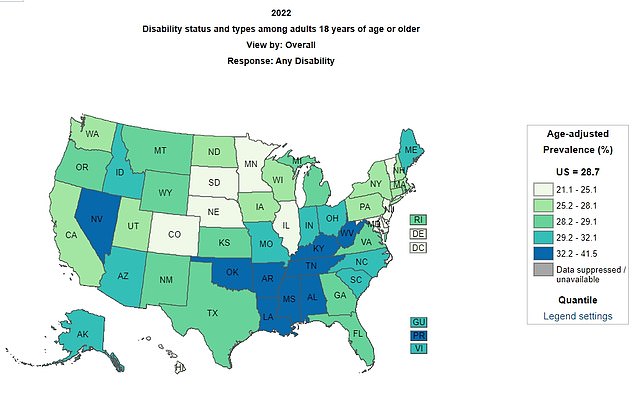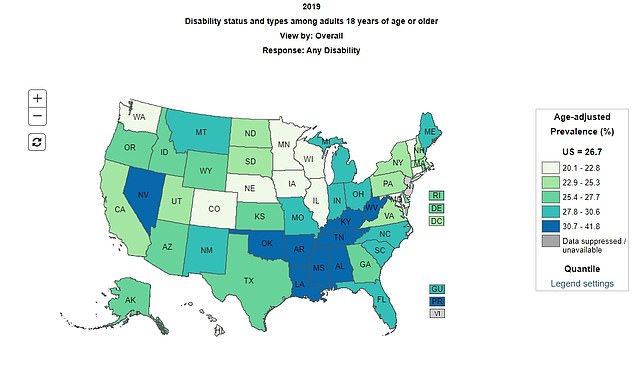Record one in FOUR Americans claim they are disabled - the equivalent of 70million - CDC data shows
- READ MORE: California care home for autistic adults is hit by torture scandal
More than one in four American adults say they have some type of disability, the highest number since tracking began nearly a decade ago.
The number reached 71million in 2022 - 28.7 percent of the population - according to CDC data, which asked about cognitive, visual, and mobility-related disabilities.
This is up from 61 million, or 24.6 percent of adults, in 2016, the first year the CDC began collecting data on the demographic.
There are multiple reasons behind the rise - including an aging population and an increase in chronic conditions like diabetes, arthritis and obesity.
And now, the CDC suggested it may also be linked to long Covid, which was included in the survey for the first time.

The above map drew from data submitted to the 2022 Behavioral Risk Factor Surveillance System (BRFSS), which collected accounts of long Covid symptoms contributing to high disability rates

The first year that data was tracked, 61 million Americans reported having some kind of disability
The CDC tracks disability types, including hearing, vision, cognition, mobility, self-care, and independent living.
In its collection of data, it asked whether people have various hearing and vision disabilities, whether they can move and perform tasks by themselves, have difficulty concentrating, and more.
The CDC's reports were voluntarily given by members of the public, meaning the agency could not confirm the medical accuracy of the reports.
Data collected in 2022, the most recent year available, seven percent of Americans reported they had long Covid, around 18million adults.
Long Covid is marked by a long roster of lingering symptoms after a Covid infection, including respiratory issues, chronic fatigue, brain fog and headaches.
Research into long Covid is underway, though there has been some skepticism about whether it is a distinct condition or just a constellation of background symptoms.
According to the CDC data, Arkansas had the highest number of residents with a disability, with 38 percent of people reporting having some kind of disability.
This was followed by West Virginia, with 37 percent, and Louisiana and Mississippi at 36 percent.
Washington, DC and Hawaii had the lowest rates of disability, with 21 percent and 22 percent, respectively reporting a disability. After those states came New Jersey with 23 percent and Illinois with 24 percent.
A previous report from the CDC said the highest rates of disabilities fall within rural counties, where an estimated one-third of residents have a disability.
Disability rates skewed higher in states with more rural, remote regions than urban ones, which could be due to less access to care, including preventative care, occupational hazards in industries such as mining and agriculture, and the fact that rural regions tend to have an overall older population.
The latest figures were determined based on entries in the 2022 Behavioral Risk Factor Surveillance System (BRFSS), which allows respondents to self-report on up to six functional types of disability.
For the first time in its round-up, the CDC included a question on long Covid-related symptoms that disabled people, though it stopped short of calling long Covid a disability in and of itself.
It ‘collected data on experiences with Long COVID, defined as symptoms lasting three months or longer that the person did not have before COVID, to help us better understand the relationship between disabilities and Long COVID.’

Disability rates were lower than those from 2022 in 2019, a year before the Covid pandemic which left millions with long Covid symptoms

Rural areas of the country saw higher rates of disability, likely because access to preventative healthcare is more scarce in rural areas, and those regions tend to have older populations
The report did not, however explicitly say that disabilities reported in the BRFSS were directly linked to long Covid, yet the data helps better understand the relationships between disabilities and long Covid.
Specifically, participants were classified as having one of six disability types if they answered ‘yes’ to questions about whether they are deaf or blind even when wearing glasses, have difficulty concentrating or making decisions, have difficulty walking or climbing stairs, cannot bathe or dress independently, or have trouble doing errands alone.
Long Covid symptoms were more common among people with disabilities than those without – about 11 and seven percent, respectively.
The agency said: ‘CDC continues to collaborate with clinicians, public health partners, and other federal agencies to better understand the impacts of Long COVID, more generally, and, given the data, better identify and support the needs of people with disabilities.’
Older adults reported the highest rate of disability compared to other age groups, at 44 percent of people over 65.
And when examining disability status by race/ethnicity, the groups with the highest prevalence, both about 39 percent, identified as American Indian or Alaska Native and Other/Multirace.
The CDC has said previously that among working-age adults with only one disability, the most common type was disability in mobility (34 percent), followed by hearing (24 percent) and cognition (about 23 percent).
The CDC said: ‘These findings underscore the fact that people with disabilities are a large part of every community and population. Many of us know, or are, someone with a disability, and disability inclusion is beneficial for all.
‘It’s important to remember disability is not a health outcome; it is part of the way people experience life, such as hearing, seeing, moving, processing information, and caring for oneself.’





























































































































































































































































































































































































































